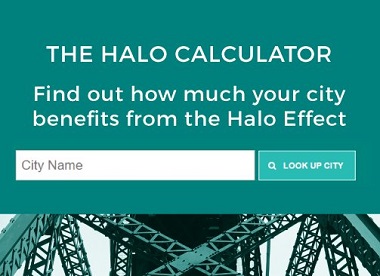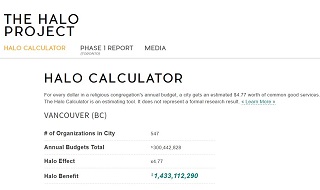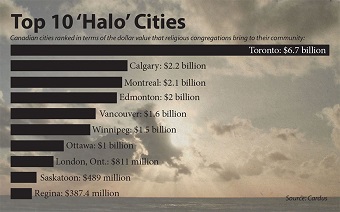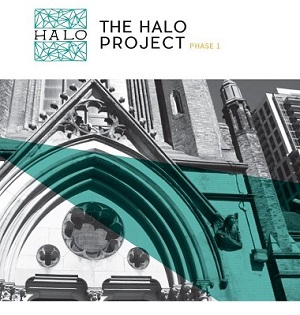 Church-goers know the many benefits of participating in a congregation. Outsiders might not be convinced – and sometimes even feel that churches (mosques, synagogues, temples) are parasitic and should be paying taxes.
Church-goers know the many benefits of participating in a congregation. Outsiders might not be convinced – and sometimes even feel that churches (mosques, synagogues, temples) are parasitic and should be paying taxes.
Now there is a good way to assess the contributions of religious congregations which should encourage parishioners and convince skeptics.
Cardus Social Cities has just released “two new tools that will help you and your organization measure the socio-economic impact that places of worship have on the community: the Halo Calculator and the City Soul Explorer Toolkit.”
The Halo Calculator
 The Halo Calculator is an estimating tool which helps users determine how much benefit a city receives from congregations.
The Halo Calculator is an estimating tool which helps users determine how much benefit a city receives from congregations.
Social Cities states: “For every dollar in a religious congregation’s annual budget, a city gets an estimated $4.77 worth of common good services.”
For the City of Vancouver, according to the Halo Calculator, that adds up to $1,433,112,290. That is, $300,442,828 (the annual budgets of 547 religious congregations) times the ‘Halo Effect’ multiplier, 4.77.
 For the 10 major municipal centres in Canada the figure is almost $19 billion with Toronto at 6.7 billion, followed by Calgary at 2.2 billion.
For the 10 major municipal centres in Canada the figure is almost $19 billion with Toronto at 6.7 billion, followed by Calgary at 2.2 billion.
Figures are available for all Metro Vancouver cities – for example:
- North Vancouver ($99,959,772)
- Coquitlam ($101,953,298)
- Burnaby ($407,363,381)
- Surrey ($601,358,303)
Milton Friesen interview
Milton Friesen, program director for Cardus Social Cities spoke with Danielle Smith on AM770 in Calgary May 31. Following is a portion of the interview:
Danielle Smith: I can wrap my head around the idea of a hockey tournament and the economic impact of it, because people will come to a city, they have to rent hotel rooms, they have to go out and eat, they’re probably doing a bit of shopping. . . . But you use a bunch of different metrics when you’re talking about these religious institutions. What do you look at?

Milton Friesen was interviewed about the Halo Calculator.
Milton Friesen: The core is, it’s important to recognize in the U.S. [where the model was developed] they used 49 measures – they didn’t make up those measures; they used what economic development people might typically use – and then tuned some of them towards the particular context. . . .
We modified some of them for the Canadian setting, but otherwise used them as a way of trying to get a handle around what’s the effect. Is it positive, is it negative, is it neutral – we weren’t sure either. We wanted to take an honest look at that.
The important thing that we looked at was it’s not the same kind of economic generation as if you had an auto plant that you’re going to get set up in your community and start manufacturing. We actually need to think about it in a reverse way, which is, if a given institution left its community, and the services and the goods that it’s providing now have to be paid for by the city or they have to be replaced in some way, what would the cost of that replacement be?
Could the cities afford it, would the community actually fill that gap? If they didn’t, what’s the size of the price tag to take care of what was left. If they couldn’t do it, of course, quality of life would decline, services would decline, etc. So that idea of a replacement cost is really one of the key ideas in the study . . .
DS: So, let’s talk about a few of those, just so people can wrap their heads around what you’re measuring. I’ve been to countless community events that have been hosted at churches, at either very low cost or no cost at all. Childcare, that’s one thing that often gets provided at religious institutions. Suicide and crime prevention – that’s sort of an interesting thing that I hadn’t considered. Housing – I hadn’t considered that as well. Then you say a long list of things, obviously, because you’ve got 49 measures. But give us another couple of ideas about what would be things that you would have to spend money to replace if the religious institution wasn’t providing it.
MF: It’s important to point out that not all the religious communities provide all of these things. . . . But we look at things, for instance, like the value of the volunteer time that’s put into all the different programs that are carried out, sometimes directly by the congregations, sometimes by other community groups that use the facilities. That lets us do a calculation in terms of what does that volunteer time look like. . . .
Social programs; space is quite an important one. . . . It’s important to recognize there’s a good segment of Canadians that have no religious belief, and what we’re trying to suggest, and what the research suggests, is that even if you’re not part of these communities they’re having a positive, generative effect on your community.
For the full interview – including how the multiplier was calculated, the issue of whether churches should be paying taxes and the potential effect of this study on that debate – go here.
How it works
 Cardus Social Cities makes four points about the Halo Calculator (go here for the full account):
Cardus Social Cities makes four points about the Halo Calculator (go here for the full account):
- The Halo Calculator is an estimating tool. It does not present formal research results. There are variances across community sizes, locations and charitable entities. Yet for charitable places of worship, their generative nature appears to be significant and it is hoped that the Calculator will spark discussion, exploration and further research.
- The Halo Calculator is based on figures obtained in the 2016 Toronto Halo Report. That report examined the economic ‘halo effect’ of 10 local congregations on their respective communities in Toronto. This study was based on an earlier study pioneered by Dr. Ram Cnaan at the University of Pennsylvania. When “Direct Spending” is compared with “Total Value” a ratio of 1:4.77 is obtained. The Calculator suggests for every dollar of direct spending across the 10 congregations examined, about $4.77 of common good benefit is generated.
 By extension, the Halo Calculator estimates “Direct Spending” for every registered charitable congregation or place of worship in a given community by means of data filed by those charities with the Canada Revenue Agency in a form called the T3010. The closest comparison to the “Direct Spending” category in the Halo Report is the “Total Expenditures – 5100” column in the T3010. Again, to be more conservative, the “Total Revenues – 4700” column is used at it tends to be comparable to the 5100 column but is slightly less.
By extension, the Halo Calculator estimates “Direct Spending” for every registered charitable congregation or place of worship in a given community by means of data filed by those charities with the Canada Revenue Agency in a form called the T3010. The closest comparison to the “Direct Spending” category in the Halo Report is the “Total Expenditures – 5100” column in the T3010. Again, to be more conservative, the “Total Revenues – 4700” column is used at it tends to be comparable to the 5100 column but is slightly less. - The Halo Calculator only counts a certain subset of registered charities. Its data includes only Registered Charities designated as ‘Churches and Other Places of Worship.’ [Mosques, temples, gurdwaras, etc are included along with churches. But ministries such as UGM, Salvation Army and Catholic Charities are not included; nor are health or educational institutions.]
- The Halo Calculator data are vetted but come with caveats. McMaster University vetted the T3010 (2013) data via their Public Economic Data Analysis Lab (PEDAL). This data verification does not imply endorsement of the way in which the Halo Calculator is being used to generate a Halo Effect value. . . .
 City Soul Explorer Toolkit
City Soul Explorer Toolkit
Cardus Social Cities released a second tool along with the Halo Calculator. Following is their description:
The City Soul Explorer Toolkit offers four modules and practical tools to facilitate communication and closer collaboration between city planning and faith-based organizations.
The Toolkit outlines a way in which the often distinct worlds of city planners and administrators and community-serving religious organizations can be bridged and brought closer together to build the social capacity of cities, towns and neighbourhoods.
Go here for the full 40-page report.

The Halo Calculator very nicely teases out many of the below-the-radar values of faith-based institutions to the cities in which they operate. One comment emerges: It would be interesting to have clarification of the relative Toronto ($6.7 billion) and Vancouver ($1.4 billion) values.
My theory. Toronto is based on what is commonly called the Greater Toronto area (GTA) which extends well beyond the city of Toronto and has a total population of around six million. Vancouver is based strictly on the City of Vancouver, which has a population of 600,000 – 10 percent of the GTA.
If one were to apply comparable GTA to Greater Vancouver population-to-Halo figures, we would need to include all the cities surrounding Vancouver, eat to Langley and Maple Ridge and south to the US border. That would stack up to some 2.5 million and provide a Halo value of around $2.7 billion.
I would be interested to know, from Milton Friesen, if my theory holds water. The reason it might matter is that in some provinces, such as British Columbia, civic governance is much more decentralized than in other provinces, such as Ontario. This means neighbourhoods and smaller surrounding cities need to be weighed in, in the more decentralized metropolitan areas.